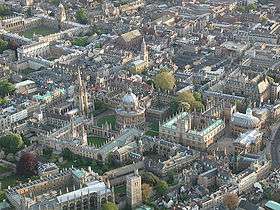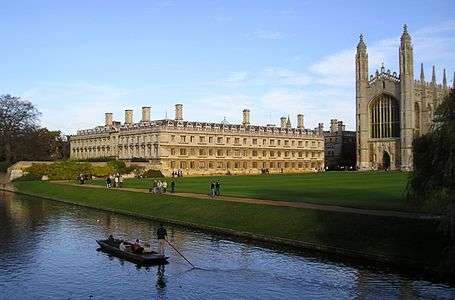Ancient university

The ancient universities are seven extant British and Irish medieval universities and early modern universities founded before the year 1600.[1] Four of these are located in Scotland, two in England, and one in Ireland. The ancient universities in Britain and Ireland are amongst the oldest extant universities in the world.
Foundation
The surviving ancient universities in England, Scotland and Ireland are, in order of formation:
| Year | Name | Contemporary location | Current location | Notes |
|---|---|---|---|---|
| 1096 | University of Oxford | Kingdom of England | Oxford, England, UK | "There is no clear date of foundation, but teaching existed at Oxford in some form in 1096 and developed rapidly from 1167, when Henry II banned English students from attending the University of Paris."[2] Teaching suspended in 1209 (due to town execution of two scholars) and 1355 (due to the St. Scholastica riot). |
| 1209 | University of Cambridge | Kingdom of England | Cambridge, England, UK | Founded by scholars leaving Oxford after a dispute caused by the execution of two scholars in 1209. |
| 1413 | University of St Andrews | Kingdom of Scotland | St Andrews, Scotland, UK | Founded by a Papal Bull building on earlier bodies established between 1410 and 1413 |
| 1451 | University of Glasgow | Kingdom of Scotland | Glasgow, Scotland, UK | Founded by a Papal Bull |
| 1495 | University of Aberdeen | Kingdom of Scotland | Aberdeen, Scotland, UK | King's College was founded in 1495 by Papal Bull and Marischal College in 1593; they merged in 1860 |
| 1582 | University of Edinburgh | Kingdom of Scotland | Edinburgh, Scotland, UK | Established by a Royal Charter granted by James VI |
| 1592 | University of Dublin | Kingdom of Ireland | Dublin, Ireland. | Founded by Charter of Queen Elizabeth I; Trinity College[1][3][4] is the only constituent college of the university |
These universities often find themselves governed in a quite different fashion to more recent additions. The ancient universities of Scotland also share several distinctive features and are governed by arrangements laid down by the Universities (Scotland) Acts. In addition to these universities, a number of now-obsolete universities were founded during this period, including the University of Northampton (1261–1265), royal attempts to establish universities in Fraserburgh and Durham, plus the predecessor institutions to the University of Aberdeen founded in 1495 and 1593 (noted above).
Undergraduate Master of Arts degree
The ancient universities are distinctive in awarding the Magister Artium/Master of Arts (MA) as an undergraduate academic degree. This is commonly known as the Oxbridge MA, Trinity MA (Dublin), or the Scottish MA.
The ancient universities in Scotland confer the MA degree at graduation with honours and a final mark; in contrast, the ancient universities in England and Ireland award the MA purely after a period of good standing following graduation as Bachelor of Arts, usually around three years.
Because they award the MA as an undergraduate Arts degree, the ancient universities award differing titles for their postgraduate master's degrees in the Arts and Humanities, such as the taught Master of Letters ("MLitt (T)"). Some confusion can arise as to whether such degrees are taught degrees or the most established (and advanced) two-year research degrees, although this is often specified.
Universities (Scotland) Acts

As mentioned above, the Universities (Scotland) Acts created a distinctive system of governance for the ancient universities in Scotland, the process beginning with the 1858 Act and ending with the 1966 Act. Despite not being founded until after the first in these series of Acts, the University of Dundee shares all the features contained therein.
As a result of these Acts, each of these universities is governed by a tripartite system of General Council, University Court, and Academic Senate.
The chief executive and chief academic is the University Principal who also holds the title of Vice-Chancellor as an honorific. The Chancellor is a titular non-resident head to each university and is elected for life by the respective General Council, although in actuality a good number of Chancellors resign before the end of their 'term of office'.
Each also has a Students' Representative Council as required by statute, although at the University of Aberdeen this has recently been renamed the Students' Association Council.[5]
Later universities
Following the creation of the ancient universities, no more universities were created in Britain and Ireland until the 19th century. Precisely which of these 19th-century institutions was the earliest post-ancient university is a matter of debate. In brief, the main university-level foundations after this time are:
- St David's College, Lampeter was established in 1822 (Royal Charter 1828),
- University College London in 1826 (Royal Charter 1836 when it joined with King's College London to form the University of London)
- King's College London in 1829 (Royal Charter 1829)
- University of Durham in 1832 (Royal Charter 1837).
In addition the University of Strathclyde in Glasgow traces its origins back to the Andersonian Institute of 1796, but did not receive a Royal Charter until 1964.
The more recent red brick universities of the later 19th century and early 20th century such as the University of Birmingham were soon to follow. Thereafter in the 1950s and 60s the "plate glass universities" were formed and after the Further and Higher Education Act 1992, polytechnics were granted university status.
References
- 1 2 "Radcliffe dean to lead historic university in Scotland". Ukinusa.fco.gov.uk. Retrieved 2012-02-17.
- ↑ A brief history of the University of Oxford, Oxford University
- ↑ http://www.tara.tcd.ie/bitstream/2262/5699/1/jssisiVolXVII594_610.pdf
- ↑ "Rise & Progress of Universities – Chapter 17". Newman Reader. Retrieved 2012-02-17.
- ↑ "University of Aberdeen Students' Association Constitution". Archived from the original on 8 April 2007. Retrieved 2007-04-21.





